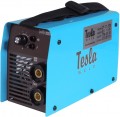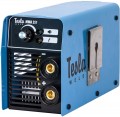Open circuit voltage
The voltage supplied by the welding machine to the electrodes. As the name suggests, it is measured without load — i.e. when the electrodes are disconnected and no current flows between them. This is due to the fact that at a high current strength characteristic of electric welding, the actual voltage on the electrodes drops sharply, and this does not make it possible to adequately assess the characteristics of the welding machine.
Depending on the characteristics of the machine (see "Type") and the type of work (see "Type of welding"), different open circuit voltages are used. For example, for welding transformers, this parameter is about 45 – 55 V (although there are higher voltage models), for inverters it can reach 90 V, and for semi-automatic MIG / MAG welding, voltages above 40 V are usually not required. Also, the optimal values \u200b\u200bdepend on type of electrodes used. You can find more detailed information in special sources; here we note that the higher the open-circuit voltage, the easier it is usually to strike the arc and the more stable the discharge itself.
Also note that for devices with the VRD function (see "Advanced"), this parameter indicates the standard voltage, without reduction through VRD.
Min. welding current
The smallest current that the device is able to supply through the electrodes during operation. For different materials, different thicknesses of the parts to be welded and different types of welding itself, the optimal welding current will be different; there are special tables that allow you to determine this value. The general rule is that a high current is far from always useful: it gives a rougher seam; when working with thin materials, it is possible to melt through the junction instead of connecting the parts, not to mention excessive energy consumption. Therefore, if you have to work with parts of small thickness (2-3 mm), before choosing a welding machine, it makes sense to make sure that it is capable of delivering the desired current without “busting”.
Max. welding current
The highest current that the welding machine is capable of delivering through the electrodes during operation. In general, the higher this indicator, the thicker the electrodes the device can use and the greater the thickness of the parts with which it can work. Of course, it does not always make sense to chase high currents — they are more likely to damage thin parts. However, if you have to deal with large-scale work and a large thickness of the materials to be welded, you simply cannot do without a device with the appropriate characteristics. Optimum welding currents depending on materials, type of work (see "Type of welding"), type of electrodes, etc. can be specified in special tables. As for specific values, in the most “weak” models, the maximum current
does not even reach 100 A, in the most powerful ones it can exceed
225 A and even
250 A.Duty cycle
The duty cycle allowed for the welding machine.
Almost all modern welding machines require breaks in operation — for cooling and general "recovery". The frequency of inclusion indicates what percentage of the time of the total work cycle can be used directly for work. In this case, 10 minutes is usually taken as a standard cycle. Thus, for example, a device with a duty cycle of
30% will be able to work continuously for less than 3 minutes, after which it will need at least 7 minutes of interruption. However, for some models, a cycle of 5 minutes is used; these nuances should be clarified according to the instructions.
In general, high frequency is required mainly for high-volume professional work; with a relatively simple application, this parameter does not play a decisive role, especially since you have to take breaks during work. As for specific values, the mentioned 30% is a very limited figure, typical mainly for entry-level devices. A value of
30 – 50% is also low; in the range of
50 – 70% is the majority of modern devices, and the most "hardy" models provide a frequency
of more than 70%.
Max. electrode size
The largest diameter of the electrode that can be installed in the welding machine. Depending on the thickness of the parts, the material from which they are made, the type of welding (see above), etc. the optimal electrode diameter will be different; there are special tables that allow you to determine this value. Large diameter may be required for thick materials. Accordingly, before purchasing, you should make sure that the selected model will be able to work with all the necessary electrode diameters.
In modern welding machines, an electrode diameter
of 1 mm or less is considered very small,
2 mm — small,
3 mm and
4 mm — medium, and powerful performant models use
electrodes of 5 mm or
more.
Protection class (IP)
The protection class to which the housing of the welding machine corresponds.
This parameter is traditionally denoted by the IP standard with two digits. It characterizes how well the case protects the hardware from foreign objects and dust (first digit), as well as from moisture (second digit). It is worth noting that in welding machines the degree of such protection is usually small — this is due to the fact that the case must be made ventilated. Here are the levels of protection against solid objects / dust that are relevant for modern models:
1 — protection against objects larger than 50 mm (comparable to the size of a human fist or elbow);
2 — from objects larger than 12.5 mm (we can talk about protection from fingers);
3 — from objects larger than 2.5 mm (the probability of accidental hit by most standard tools is excluded);
As for protection against moisture, it can be generally zero — that is, such a device can only be used in dry conditions. However, there are more advanced options:
1 — protection against drops of water falling vertically, with a strictly horizontal position of the device (the minimum degree of protection, in fact — from accidental ingress of a small amount of moisture);
2 — from vertical drops of water when the device deviates from the horizontal up to 15 ° (slightly higher than the minimum);
3 — from splashes falling at an angle of up to 60 ° to the vertical (we can talk about protect...ion from rain);
4 — from splashes falling from any direction (possibility of use in rain with strong winds);
Sometimes, instead of one of the numbers, the letter X is put — for example, IP2X. This means that the protection class for the corresponding type of exposure is not defined. In such a case, it is best to assume that there is no protection at all — this will provide maximum security and avoid unpleasant surprises.
Insulation class
The insulation class determines the degree of resistance of the insulating materials used in a particular device to heat. To date, welding machines use materials mainly of the following classes:
B — have a resistance limit of 130 °C;
F — 155 °C;
H — 180 °C.
Note that the vast majority of modern welding machines have electronic overheating protection, which turns off the device long before reaching the insulation resistance limit. Therefore, this parameter will be relevant only in an emergency, when the built-in protection fails. Nevertheless, it fully allows you to assess the safety of using the device — the higher the insulation class, the more likely it is to notice dangerous overheating in time (for example, by a characteristic smell) and turn off the device before damage occurs.

